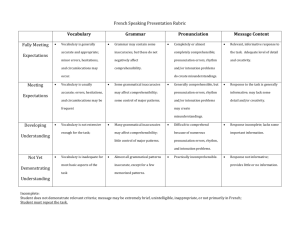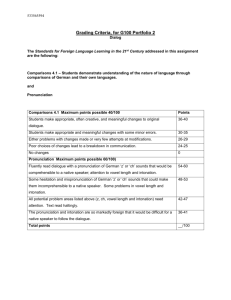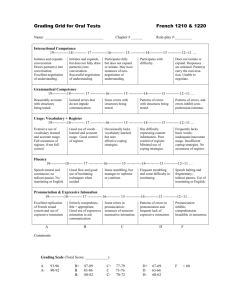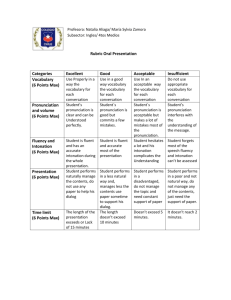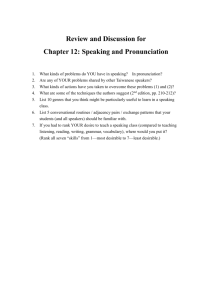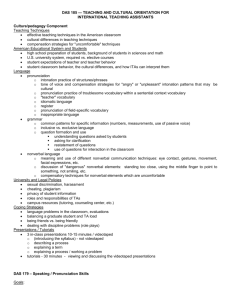and save the article to your computer
advertisement
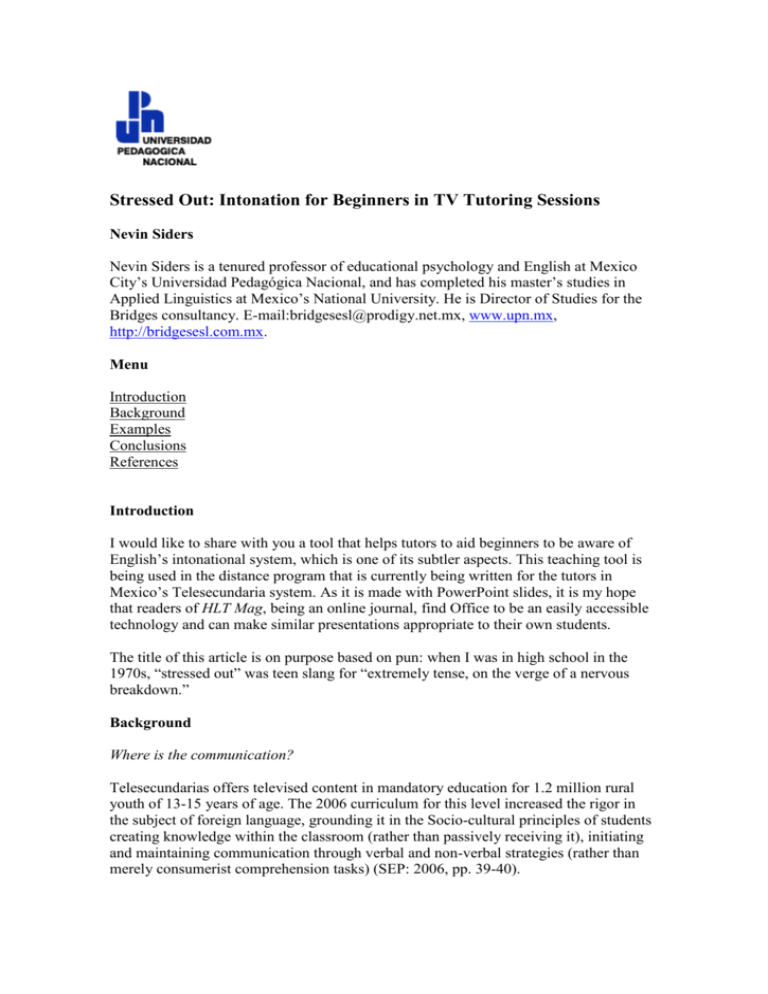
Stressed Out: Intonation for Beginners in TV Tutoring Sessions Nevin Siders Nevin Siders is a tenured professor of educational psychology and English at Mexico City’s Universidad Pedagógica Nacional, and has completed his master’s studies in Applied Linguistics at Mexico’s National University. He is Director of Studies for the Bridges consultancy. E-mail:bridgesesl@prodigy.net.mx, www.upn.mx, http://bridgesesl.com.mx. Menu Introduction Background Examples Conclusions References Introduction I would like to share with you a tool that helps tutors to aid beginners to be aware of English’s intonational system, which is one of its subtler aspects. This teaching tool is being used in the distance program that is currently being written for the tutors in Mexico’s Telesecundaria system. As it is made with PowerPoint slides, it is my hope that readers of HLT Mag, being an online journal, find Office to be an easily accessible technology and can make similar presentations appropriate to their own students. The title of this article is on purpose based on pun: when I was in high school in the 1970s, “stressed out” was teen slang for “extremely tense, on the verge of a nervous breakdown.” Background Where is the communication? Telesecundarias offers televised content in mandatory education for 1.2 million rural youth of 13-15 years of age. The 2006 curriculum for this level increased the rigor in the subject of foreign language, grounding it in the Socio-cultural principles of students creating knowledge within the classroom (rather than passively receiving it), initiating and maintaining communication through verbal and non-verbal strategies (rather than merely consumerist comprehension tasks) (SEP: 2006, pp. 39-40). This is alone a huge challenge in a country where it is taken for granted that teachers have no knowledge of the subject matter (the English language). Yet the challenge is doubled when we consider that in Telesecundaria those in front of the classroom are not teachers by trade, but are tutors: an adult with a bachelor’s degree in any field and the good will to help rural youth. And this challenge is doubled yet again because the mode is distance education - one-way transmission by TV. The obvious quandary for any language teacher is of the most fundamental nature. How can one-way transmission of content be transformed into communicative language learning? In a word: Where is the communication? What is Intonation? The mechanical part of communication is in sharing a code. Crystal’s Encyclopedia of Language (p. 107) describes the great volume of information intonation transmits: grammatical, pragmatic, social, and propositional! It further describes three physical properties that together make up intonation (properly termed prosody). One speaks in a high or low tone, which is the “pitch.” Second, the volume may range from quiet to loud. Third, “tempo” corresponds to what we do when we clap our hands while singing a song. The synergy of these three properties is known as the rhythm, as shown in this formula. (p. 171) pitch + loudness + tempo = rhythm Of some eight thousand languages in the world, much more than seven thousand have a rhythm that goes syllable-by-syllable. Thus, every word is virtually guaranteed to be pronounced clearly. However, English is one of very few languages with a rhythm that does not permit syllables to come out clearly. Linguists term this unique rhythm as “stress-timed”. (ibid 171) (An aside: The stress-timed aspect is true for native speakers of English. Yet for every native speaker there are two non-native speakers, and statistics from recent years show that among this majority the rhythm is like that of most languages. Therefore, among themselves, most syllables are pronounced clearly!) English’s stress-timed prosody is evident in children’s rhymes. (I suggest you open another window now and type “Mother Goose” in Google or Yahoo! You’ll find countless versions of nursery rhymes, many of them with recordings. Among them is a site by the U.S. National Institute of Environmental Health Sciences (2007).) You can hear how several words are grouped together into a single group, a “musical beat.” Alma Dzib’s doctoral thesis (2007) on the very topic of prosody points out how “prosody is an aspect of language that goes beyond verbal communication, insofar as it includes intonation (voice, tone, and fluctuations), tension, pauses and rhythm of speech.” prosodic structures are used to organize the representation of a phrase in working memory while comprehension processes. phrases must adapt to the listener’s auditory system. prosody’s melodic wave allows us to compensate for error in the syntactic structure. (p. 2) Teacher Training Books Many books to train teachers tell us how students must appreciate this “musical” aspect of the language. In your initial teacher training, it is quite likely that you were assigned readings from one of these excellent manuals. Two seminal works, Pronunciation (Dalton and Seidlhofer, 1994) and Teaching Pronunciation (Celce-Murcia et al, 1996), argue for the need to raise student awareness of “sentence stress and rhythm.” (CelceMurcia p. 154) More recently, Learning Teaching by Scrivner (2005) says that, Intonation is sometimes referred to as the ‘music’ of the language, and we use it as a kind of oral equivalent of written punctuation. It is closely connected to prominence, for the main movement of intonation begins at the tonic syllable…. Intonation has a definite effect on meaning and also gives us information about the speaker’s attitude. (pp. 295-6) Yet all three of these leave this issue at that theoretical level, offering little concrete advice on teaching strategies or techniques. Teaching Pronunciation has just one additional paragraph followed by a bullet list with brief items such as #2 “mark intonation patterns on dialogues”; #3 “hum/whistle/sing the sentence without words before you say it”; #6 “indicate intonation with hand gestures, waves, etc.”. The one that drew my attention was the “musical staff” (p. 193), but there are neither illustrations nor any further explanation of how that is to be brought about. Pronunciation Pronunciation in fact goes further, justifying the paucity of techniques. [T]here seems to be a conundrum for pedagogy here: prominence, tones, and key… are particularly important in discourse, in that they allow speakers to negotiate their relationships and to indicate how they view the topic under discussion. At the same time they are particularly difficult to teach. (p. 73) Reflecting on these readings and several others, I continue to come across more and more reasons why prosody is particularly complicated to teach. Compared to other aspects of language, (words, articulation, pauses, parts of speech, volume), intonation is almost unconscious. In the case of English, the stress-timed rhythm is totally unconscious, such as the degree that even linguists have great trouble describing it. No matter how many textbooks I leaf through, I have not found a single one for native speakers or foreign students that takes it. (Native speakers, of course, do not need to study it; it is learned years before going to school.) The above mentioned paucity in teacher training courses. Most textbooks for teachers in training include pronunciation, but this is limited to phonemes and isolated words. Only the three mentioned above even discuss prosody, but unfortunately in these it is no more than a mention. The ability to hear intonation is also a critical skill to reading English. While it is a truism that punctuation does represent part of prosody, there is much more to phrasing that is not explicit. The most obvious example is the tiny pause before every verb, that pause that infuriates every high school writing class for native speakers, because it makes it so difficult to comprehend the teacher’s lecturing on to not introduce a “comma splice.” Since much of phrasing is literally invisible within written text, most people find it problematic at best to discuss it in oral speech. I apologize for this extensive introduction, but in fact the problem is compounded for many different reasons. Let’s move on to the solutions! Examples The stress-timed rhythm of English is often described with a metaphor of music. To me it is evident that the question itself points toward a solution. Draw out that musical metaphor, and draw a musical staff. My version starts with five horizontal lines, leaving four open spaces in between. We will work in these gaps. These represent the normal tones of English. Just as in a normal musical score, the high tone is above and the low tone is below. It looks like this. Illustration 1: colored musical staff This was made in PowerPoint. All I did was to choose “insert table,” and make one that is one cell wide and four high. You will notice I have also added colors. My choice of colors is three-fold. It is a pretty, stylized rainbow, ranging from red to blue. Second, among these rainbow colors, an earthy foundation is suggested by sea and land below. But the most important reason is this: red symbolizes “hot” emotions in the Anglo culture, such as love and anger, while blue symbolizes calm and relaxed moods. Blues music is always slow, isn’t it? After some experimentation in the TV studio, we came to the conclusion that the pastel colors must be made even lighter, because in TV transmission the medium tones tended to dance on the screen. But in the classroom I have experimented with a placemat-sized version for the students to draw on, particularly where the light pink is stronger, a shade of fuchsia known in this country as Mexican Pink. This is the color you see in the illustration. The next step is to add the words and phrases. PowerPoint has several tools for adding text, what works for me is to either write inside the cells or else in those “text boxes” that float over them. The limitation for TV and other forms of projection is that not many words fit. It is problematic to demonstrate a long sentence, and more so for full discourses. Put the words into the cells of the corresponding intonation. For example, the classic rising intonation in early lessons is shown by typing most of the sentence in the green line, and the final word (or syllable) into the yellow line. Now it looks like this. Illustration 2: text of a question The clincher is in the final addition. As the Pronunciation book (Dalton and Seidlhofer, 1994: p. 48) says, use arrows! PowerPoint has a set of ready-made arrows just a couple of clicks away, straight and curved ones. Just stretch them to shape. The way it looks on TV is like these two. Illustration 3: question with arrows Illustration 4: bad news Illustration 4 shows that classic warning that a doctor or repair person says to prepare you for something very serious. As I said earlier, the blue color does double duty by demonstrating the cultural connotation of sadness. Of course, the arrows could be changed for other graphic designs such as animated bouncing balls, or the text itself flowing up and down like a live snake. More details may be added. Illustration 4 shows how I push the musical metaphor still further by including thin vertical lines, which act just like musical measures. As the narrator reads the example aloud, a metronome ticks out the beat. The words dear, news, and afraid fall on the beats. This combination makes it patently clear that rhythm is English’s foundation, upon which all the other elements fit. In the Classroom In a class with little children or a private class with an adult, physical manipulatives work as well or better. A placemat-sized chart serves as the background, and they can write directly on it with crayons and then erase later, or place pieces of paper, magnets, felt, or Cuisinaire rods, accompanied by a set of arrows of various shapes. For prereading the words would be represented with illustrations, and the arrows could be made into animal tracks and arm waving. This way they can listen to a recording many times, each time making a closer approximation to the original, and, most importantly of all, debate among themselves how it really sounds by repeating as often as they like. They can learn by negotiating meaning, in the context of solving a problem. They decide whether the tone rises or falls, and listen and repeat countless times while doing it. Students Draw their own Conclusions Students quickly come to a couple of findings. The rises and falls appear quite dramatic, at least to Spanish speakers. For most of them it is a real surprise to see that contours may be traced within individual words. In each case it must be emphasized that these are the normal mechanisms to English. Spanish speakers notice and appreciate that the range of tones is somewhat broader than their tongue. The high tone (in red), which would show anger in Spanish, is just part of the regular range in English. In other words, an English-speaker is not angry with them - what a relief! Conclusions One conclusion to draw out of this experience is that, if Dr. Gardner is right and there is such as thing as musical intelligence, and that the intelligences can be cultivated, then this tool that combines visual to musical is one way to help. Another conclusion is that it is a tool that, under a gentle hand, lends itself to students constructing their own understanding by solving intriguing problems, rather than being passive receivers. A few precautions are also in order. One is that my non-native speaking colleagues find the tones unusual, but the musical beat and the “measures” in the chart is a concept that takes a while to get used to, but becomes easier as the ear is trained. A second caution is to point out a significant limitation to the medium: the most that can appear at a time is two short sentences. Not enough text fits on a screen to recreate a whole dialogue. Finally, used under a prescriptive teaching style, it would be just as meaningless as any other tool. I will end by coming back to the underlying pedagogical issue of distance education raised at the beginning. I asked where the communication is in one-way televised tutoring. One answer has already been dealt with: the problem-solving approach provides the learner with a space to hold a dialogue - even if that is an internal dialogue sustained by an individual in a rural school in front of a TV. The other form of communication was unforeseen by the authors and producers. We had been told that the Telesecundaria teachers taking the course would not likely have access to Internet (and no interest in it whatsoever). Nonetheless, as the second pilot of the program begins transmission, the very week this article is written we received several e-mails with effusive thanks, and that for the first time they are beginning to learn some English - a clear reference to the failure when they themselves took English in Mexican schools so many years ago. Moreover, one teacher said the same techniques serve in her teaching! A conclusion for teachers is that a technology is available to address this subtle, unconscious aspect of language. And since almost every reader of HLT Mag reads it online, you’re using a computer right now, which virtually guarantees me that you also have PowerPoint or something similar, which means all you’ve got to do is scoot that there mouse over a little… Are you still reading this!? Get that mouse moving! References Celce-Murcia, Marianne; Brinton, Donna M.; Goodwin, Janet M. 1996. Teaching Pronunciation: A Reference for Teachers of English to Speakers of Other Languages. Cambridge: Cambridge University Press. Crystal, David. 1997. The Cambridge Encyclopedia of Language. Cambridge: Cambridge University Press. Dalton, Christiane; Seidlhofer, Barbara. 1994. Pronunciation. Oxford: Oxford University Press. Dzib, Alma. 2007. Prosodia. in: Siders, Proceedings: Language and Education IV. Mexico City: Universidad Pedagógica Nacional. National Institute of Environmental Health Sciences. accessed October 2007. SingAlong Songs (Midis and Lyrics). kids.niehs.nih.gov/music.htm. Scrivner, Jim. 2005. Learning Teaching. U.K.: Macmillan Education. Secretary of Public Education (SEP). 2006. Educational Reform for Junior High. www.reformasecundaria.sep.gob.mx/doc/programas/2006/planestudios2006.pdf Telesecundarias. 2006. Students and Teachers in Telesecundaria. www.telesecundaria.dgme.sep.gob.mx The Pronunciation course can be viewed here. The Creative Methodology for the Classroom course can be viewed here.


